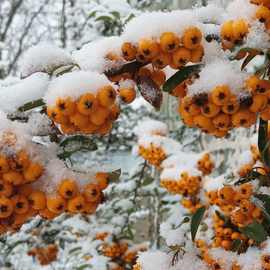 SALE
SALE







Firethorn Seeds (Pyracantha Coccinea)
0.68 €
1.14 € (Discount: 40%)
The tree has small white flowers. It produces small, bright red berries. The fruit is bitter and astringent, making it inedible when raw. The fruit can be cooked to make jellies, jams, sauces and marmalade. It ranges from southern Europe to western Asia.
-
Firethorn / Pyracantha Coccinea
Pyracantha coccinea is the European species of Firethorn that has been cultivated in gardens since the late 16th century.
The tree has small white flowers. It produces small, bright red berries. The fruit is bitter and astringent, making it inedible when raw. The fruit can be cooked to make jellies, jams, sauces and marmalade. It ranges from southern Europe to western Asia.
Hardy, Adaptable, Easy to Grow, Fast Growth, Attracts Birds, Wildlife Food/Shelter, Showy Flowers/Fruit, Hedge/Screen, Espalier, Trellis, Bonsai, Cold, Heat, Drought, Urban and Wind Tolerant
Scarlet Firethorn is a large, fast growing, semi-evergreen to evergreen shrub that is cherished for its spectacular fall and winter display of scarlet fruits and ability to withstand difficult conditions. Shooting long limber stems in all directions, an untrained Firethorn, typically grows into a tangled mound up to 18 feet in height and 12 feet wide. It is armed with sharp thorns that hide among the dark, glossy green leaves. Abundant clusters (corymbs) of small white flowers appear in spring.
The flower clusters are up to 2 inches across and are borne close together creating the appearance of nearly solid surface of flowers. In fall the 1/4 inch berries begin to ripen, their color mellowing from green to shades of red and orange. These persist through winter and into early spring depending on climate and appetite of the local bird population.
The prolific flowers are lovely to behold and have some fragrance (although not all would agree that it is appealing). Birds, especially cedar waxwings, like the plump, colorful berries. The brilliant berry-laden branches of Firethorn hold up extremely well in cut arrangements and add interest and color to wreaths.
Firethorn is often used as an espalier. Held flat against a wall, it can be shaped quite creatively. Landscapers love the firethorns for their fast rate of growth and ability to withstand drought and neglect. The shrubs ruggedness and disease and pest resistance makes this plant a very popular item in commercial landscapes.
The wide-reaching stems may be pruned back as needed during warm weather as the shrub blooms on old wood. Consider using it as a formal or informal hedge. This will require some trimming and shaping for the first few years but the effort will produce impressively beautiful and secure (thorny) hedges.
